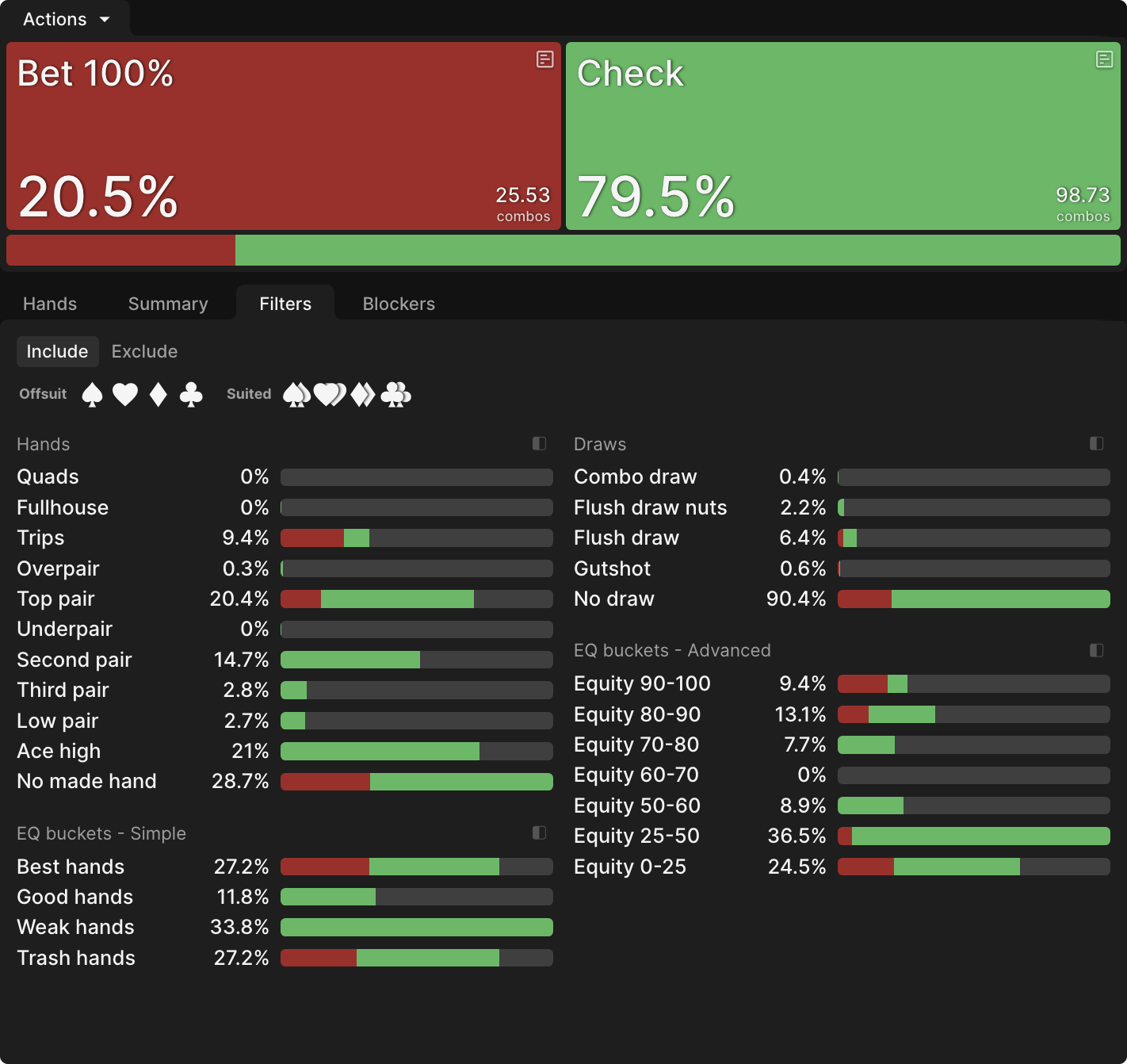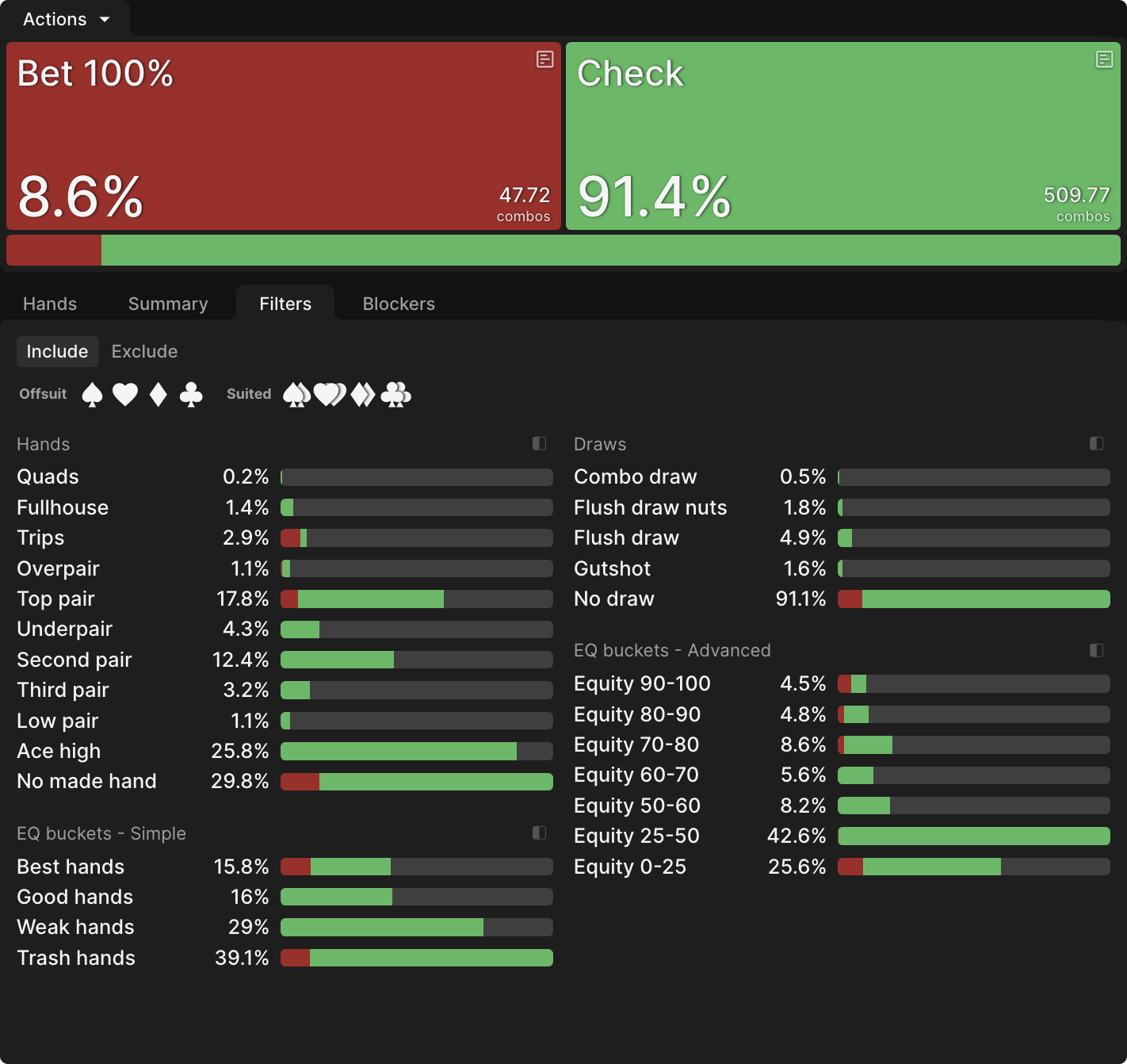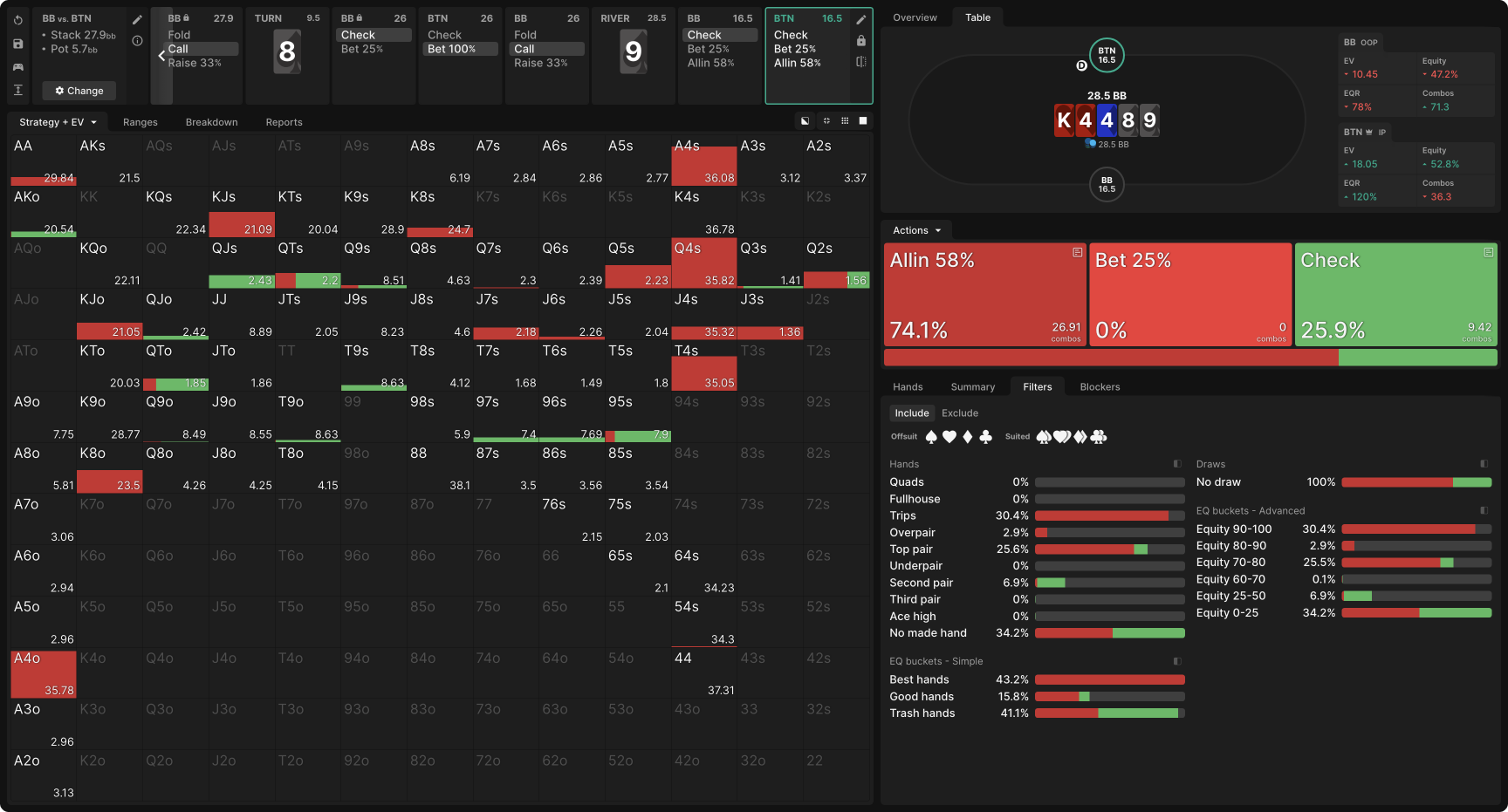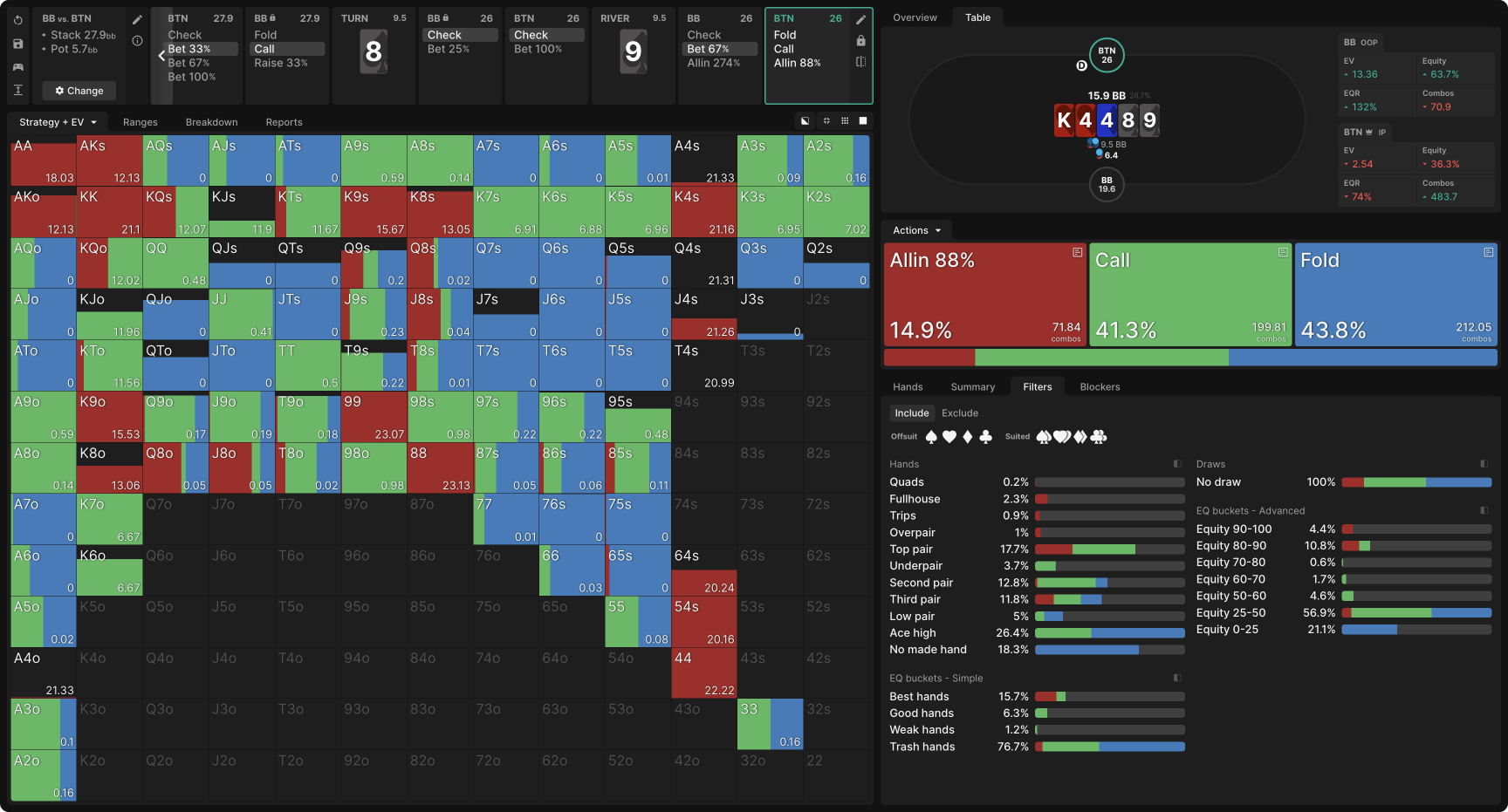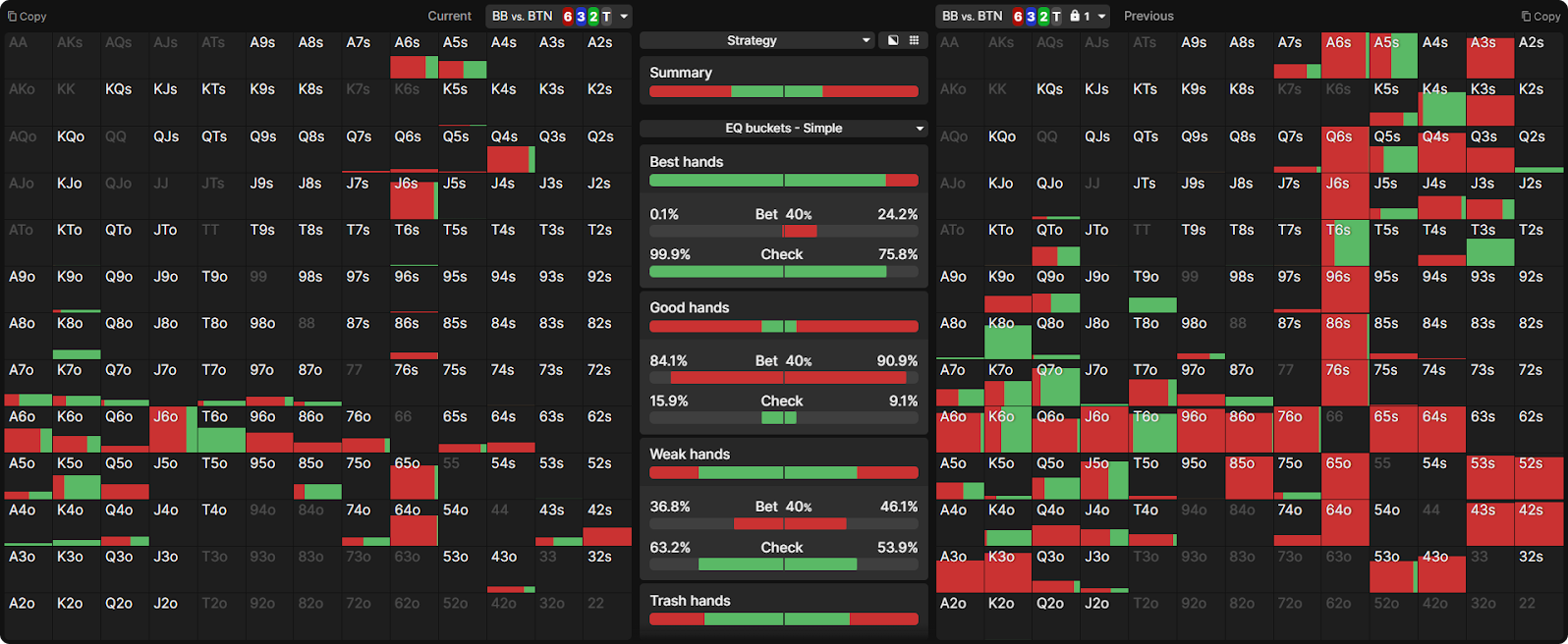Adjusting on Later Streets After Exploiting Flop
The key to exploiting opponents profitably is knowing when to stop. I’m not referring to how often you can get away with something before your opponents catch on and adjust back—that’s an important consideration, but a separate one. Rather, I mean understanding that your assumptions and adjustments on earlier streets will have implications on your later street play.
For example, suppose you suspect an opponent folds too often, so you bluff the flop with a hand you ordinarily would not. But this time, your opponent doesn’t fold; they call instead. Should you keep bluffing the turn or give up?
Assumptions about your opponent’s flop strategy and adjustments to your own strategy (based on those assumptions) warp the play on later streets.
In fact, this is a consideration even if you held a hand you would ordinarily bet on the flop and turn. Your assumptions about your opponent’s flop strategy and adjustments to your own flop strategy warp the play on later streets, even if those later streets were not the subject of the read on which you based your exploit. Because both you and your opponent will take different ranges to those later street situations than a solver would, your baseline, solver-approved strategy will be a less reliable guide. You will need to make some judgment calls on the fly and adapt accordingly.
But don’t worry! Game theory can help you with these decisions as well. Using the new nodelocking feature, we can investigate the downstream consequences of early street exploits and derive some heuristics to guide these adjustments.
Double Barreling
A good exploit against passive opponents is to continuation bet more aggressively. In this article, we found that even in spots where the preflop raiser’s equilibrium strategy involves a low continuation betting frequency, betting their entire range is a profitable exploit when the BB does not raise as aggressively as they should.
This does raise the question, however, of how to play the turn and river if the BB calls. With 30bb stacks on a K♥4♥4♦ flop, BTN’s equilibrium strategy is to continuation bet 22% of their range for 33% of the pot. If called (and if the BB is forced to check the turn, a stipulation we’ll discuss later), they follow through about 20% of the time with a pot-sized bet on a turned 8♠. The double barreling range is polarPolarized
Describes a range that is mainly very strong made hands or bluffs, with very few middle strength hands., consisting of only their best and worst hands.
In a simulation that locked BB’s flop node to only raise half of the time, BTN barrels the 8♠ turn less than 7% of the time. The bet size and the types of hands they bet remain the same; only the frequency is reduced:
A side-by-side comparison of the equity distribution graphs demonstrates the underlying cause of the reduced barreling frequency. Not only does BB have much more equity in general in the nodelocked simulation, but they specifically have more nutty hands.
BTN, meanwhile, has a much weaker turn range in the nodelocked simulation, since they bet their entire range on the flop rather than a carefully chosen—and disproportionately strong—22%.
BTN took a cheap shot at some fold equity, and after not getting a fold, they now mostly give up
Because BB sees the turn with a stronger range in the nodelocked simulation while BTN’s is much weaker, BTN no longer wishes to grow the pot. Thanks to BB’s passivity, the flop bet was immediately profitable. BTN took a cheap shot at some fold equity, and after not getting a fold, they now mostly give up with their weak hands and try to take what showdown value they can.
This is also why I forced BB to check. After not being allowed to check-raise the flop optimally, the solver would prefer to compensate by donking virtually BB’s entire range on the turn. This would confound our experiment and contradict the read that BB is an overly passive player, so in both simulations, I forced a check on the turn.
By that token, we could also continue nodelocking passivity by halving BB’s turn check-raising frequency. This does not yield dramatic results, because their response to a pot-sized barrel did not involve much raising even at equilibrium. But it does incentivize BTN to barrel somewhat more aggressively.
If BTN does barrel the turn and gets called, a 9♠ river plays out “normally”, with BB pure checking and BTN shoving a wide, polar range:
This is because BTN hardly ever bets the turn! Essentially, they accommodate their massive range disadvantage by mostly checking back and taking a free river. In the rare case that they do bet, it’s with a strong range that BB can’t exploit by raising the turn or donking the river or calling down light.
BTN accommodates their massive range disadvantage by mostly checking back and taking a free river.
In the much more common scenario where the turn checks through, BB should bet quite aggressively, including with all their worst hands:
That they are purely bluffing their worst hands implies BTN is not defending at MDF. This is the result of all the nodelocking on earlier streets. BB didn’t check-raise the flop nor donk bet flop or turn when they could have, so they are reaching the river with a disproportionately strong range, and therefore, they are going to get profitable bluffs.
When BB reaches the river with a disproportionately strong range, they will get profitable bluffs.
BTN mostly folds when they don’t have a pair, and this is a tough board to make a pair on.
BTN has benefited from BB’s earlier passivity by getting to realize equity with weak hands that would have folded to a raise from a more aggressive opponent. With Q♣J♣, for instance, they got to bet the flop for a cheap shot at denying their opponent’s equity, and when that didn’t pan out, they enjoyed high equity realization themselves by seeing the turn and river cards. If they still haven’t improved by the river, they may get some equity denied by a bluff, but they’re no worse off than they would have been by having to fold to a flop check-raise against a more aggressive opponent.
In practice, you should fold even more than this solution indicates. Nothing about BB’s river strategy is nodelocked, so the response shown here acknowledges that BB may well act on their incentive to bluff aggressively. Even so, UTG does not do a lot of bluff catching. If your assumption on all earlier streets was that BB would be too passive, then you could stick with that read and lean on the side of folding all your bluff catchers on the river.
It’s also worth noting that the nodelocked solver strategy has BB floating the flop quite aggressively, in anticipation of profitable river bluffs if the turn checks through. This is the next best thing to check-raising the flop and donk betting the turn, both of which BB was restricted from doing optimally by our nodelocks.
An opponent who over-folds the flop won’t have enough weak hands to bluff.
A real life opponent who does not check-raise this flop aggressively enough may well over-fold rather than float from out of position with hands like 6♦5♥ as the solver sometimes does. Even if this player wanted to bluff this river aggressively, they wouldn’t have enough weak hands to bluff as aggressively as the solver does, in which case all of the mixed strategy calls in the chart above would be more profitable as pure folds.
The bottom line is: if you bet the flop aggressively because you expected a passive response from your opponent, then don’t feel compelled to keep barreling the turn or to bluff catch the river. Take your equity when you can, and be ready to fold when a passive opponent gets aggressive.
Following Up An Exploitative Check-Raise
Things play out a bit differently after BB check-raises a BTN who c-bets too often on the flop. On a 6♥3♦2♣T♠ board, BB has a wider check-raising range but nevertheless follows it up with a turn bet 71.3% of the time when BTN is nodelocked to continuation bet their entire range, compared with 61.3% of the time in an unlocked simulation:
This is because BB widened their flop raising range to exploit a mistake BTN had already made, not one BB anticipated them making in response to the raise. After BTN’s initial mistake, everything else is in proportion. Because BTN’s betting range is so wide, BB can check-raise a wider range themselves without fear of exploitation. It is then correct for BTN to call the raise more liberally so both players take wider ranges to the turn than they would at equilibrium.
When BB anticipates BTN will over-fold to a flop check-raise, they can raise an even wider range, to profit from those folds. However, if BTN does not fold, the ranges are not proportionate. BB’s extra spicy check-raising strategy banks not only on the mistake BTN already made—betting too many hands—but also on a secondary mistake BB expects them to make in response to the raise. Precisely because BB expects BTN to fold too often, they should also expect BTN to have an uncommonly strong calling range.
That means BB is taking a wider-than-usual range to the turn, while BTN is taking a tighter-than-usual one. BB checks 75% of hands, more than twice what they checked in the unlocked simulation. After checking, they defend less than MDF—33% fold to a 25% pot bet—giving BTN profitable bluffs.
Precisely because BB expects BTN to fold too often, they should also expect BTN to have an uncommonly strong calling range.
This is the consequence of the exploit not panning out. BB took their shot, BTN did not fold, and now BB will frequently check and give up. This doesn’t mean they were wrong to try. It’s entirely possible their assumption was correct and they just got unlucky BTN had a better-than-average hand this time. Regardless, the best they can do when they have nothing on the turn is to cut their losses.
When you anticipate an especially good bluffing opportunity on one street, future streets will be especially bad for bluffing.
The takeaway here is that when you anticipate an especially good bluffing opportunity on one street, future streets will be especially bad for bluffing. Giving up at the right time is the difference between a profitable exploit and an expensive punt.
Conclusion
Relentless aggression is rarely optimal, even against mistake-prone opponents. You will be better served by anticipating specific mistakes on specific streets and crafting exploits accordingly. If your reads are right, these exploits should be immediately profitable.
If you don’t get the anticipated response, it’s time to re-evaluate your entire game plan. Even your “standard” line for a given spot may be suboptimal compared to one that relinquishes the pot disproportionately often to an overly strong range.
Your exploits change the game. You need to change with them.
Author
Andrew Brokos
Andrew Brokos has been a professional poker player, coach, and author for over 15 years. He co-hosts the Thinking Poker Podcast and is the author of the Play Optimal Poker books, among others.

